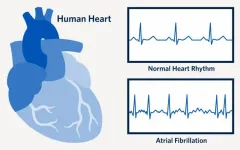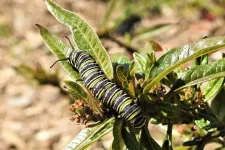(Press-News.org) Carnegie Mellon University's He Lab is focusing on noninvasive neuroengineering solutions that not only provide diagnostic techniques, but also innovative treatment options. Their latest research has demonstrated that noninvasive neuromodulation via low-intensity ultrasound can have cell-type selectivity in manipulating neurons.
Parkinson's Disease, epilepsy and insomnia are just a few of the neurological disorders that use neuromodulation treatment techniques today. Neuromodulation delivers controlled physical energy to the nervous system to treat and improve patients' quality of life. Current neuromodulation approaches, while effective, bring both drawbacks and limitations.
"Deep brain stimulation, which is highly successful, but an invasive form of electric stimulation through implanted electrodes, is one example of how neuromodulation is being used in a clinical setting today," explained Bin He, professor of biomedical engineering at Carnegie Mellon University. "Medical professionals have also used noninvasive transcranial magnetic stimulation and transcranial current stimulation, both of which lack the ability to specifically focus on the neuro-circuit level. My group is interested in helping to develop a more effective and completely noninvasive alternative."
Low-intensity transcranial focused ultrasound, or tFUS, is an emerging and fully reversable neuromodulation technology. It is noninvasive, precise, and it does not require surgery. During tFUS neuromodulation, pulsed mechanical energy is transmitted through the skull, with high spatial resolution and selectivity, at highly-targeted brain regions, which can be steered to elicit activation or inhibition through parameter tuning.
In work recently published in Nature Communications, He's group demonstrated, for the first time, that specific cell types can be targeted through tFUS neuromodulation. Their study found that excitatory neurons showed high sensitivity to ultrasound pulse repetition frequency, while inhibitory neurons did not.
This finding is significant, because it demonstrates the first capability for a noninvasive neuromodulation technique to modulate a selected cell subpopulation, using a technique that can be directly translated for human use. With the demonstrated capability of tFUS to activate excitatory or inhibitory neurons, future applications may lead to precise targeting of brain circuits using focused ultrasound energy, and activate or inhibit selected sub-populations of neurons by tuning ultrasound parameters.
"As a result of our research, we obtained direct evidence that different neuron populations unequally respond to ultrasound stimulation in the brain," said Kai Yu, co-first author of the paper and a research scientist in He's lab at Carnegie Mellon University. "We identified a critical stimulation parameter that is able to tune the balance between excitatory and inhibitory neuronal activities, and we conducted thorough control experiments to support these valuable neuroscience findings."
The application of this research has broad implications; it's not just limited to one disease. For many people suffering from pain, depression and addition, He believes non-invasive tFUS neuromodulation could be used to facilitate treatment.
"If we can localize and target areas of the brain using acoustic, ultrasound energy, I believe we can potentially treat a myriad of neurological and psychiatric diseases and conditions," said He. "This type of treatment option has great potential to shift what doctors study in medical school and go on to practice. Of course, a noninvasive, precise, reversive treatment option also presents endless benefits for patients. My dream would be to make everything noninvasive."
He's next goal is to further develop the tFUS neuromodulation technology with increased spatial resolution and focality, and directly test the applicability of tFUS to treat brain conditions in humans.
INFORMATION:
This work was supported in part by the NIH BRAIN Initiative, National Institute of Mental Health, National Institute of Biomedical Imaging and Bioengineering, National Institute of Neurological Disorders and Stroke, and National Center for Complementary and Integrative Health.
Other collaborators on the Nature Communications paper include the co-first author Xiaodan (Rachel) Niu, BME Ph.D. student, and Esther Krook-Magnuson, assistant professor of neuroscience at the University of Minnesota.
When light hits certain molecules, it dislodges electrons that then move from one location to another, creating areas of positive and negative charge. This "charge transfer" is highly important in many areas of chemistry, in biological processes like photosynthesis and in technologies like semiconductor devices and solar cells.
Even though theories have been developed to explain and predict how charge transfer works, they have been validated only indirectly because of the difficulty of observing how a molecule's structure responds to charge movements with the ...
Researchers from the UCLA School of Dentistry have discovered a key molecule that allows cancer stem cells to bypass the body's natural immune defenses, spurring the growth and spread of head and neck squamous cell cancers. Their study, conducted in mice, also demonstrates that inhibiting this molecule derails cancer progression and helps eliminate these stem cells.
Published in the journal Cell Stem Cell, the findings could help pave the way for more effective targeted treatments for this highly invasive type of cancer, which is characterized by frequent resistance to therapies, rapid metastasis and a ...
A hot topic symposia session during thePediatric Academic Societies (PAS) 2021 Virtual Meeting will provide a forum for policy and physician experts to predict major child health legislative and policy changes which will occur over the next four years.
The outcome of the presidential election has significant impact on the child health policy agenda. The goal of the session is to prepare academic pediatricians so they can be ideally positioned to promote or impede specific policies which are not evidenced-based to improve child health.
"The subject matter ...
The emergence and spread of new forms of resistance remains a concern that urgently demand new antibiotics. Transcription is a vital process in bacterial cell, where genetic information in DNA is transcribed to RNA for the translation of proteins that perform cellular function. Hence, transcription serves as a promising target to develop new antibiotics because inhibition the transcription process should effectively kill the bacteria. Bacterial RNA Polymerase, the core enzyme for transcription, must load the DNA and separate the double-stranded DNA to single stranded DNA to read the genetic information to initiate transcription. This process is also called DNA melting and is facilitated ...
ORLANDO, May 5, 2021 - New research indicates that the legendary Sargasso Sea, which includes part of the Bermuda Triangle and has long featured in fiction as a place where ships go derelict, may actually be an important nursery habitat for young sea turtles.
In a study led by a University of Central Florida researcher and published today in the journal Proceedings of the Royal Society B, researchers presented evidence of baby green sea turtles arriving at the Sargasso Sea after entering the ocean off the east coast of Florida.
The study was the first time that green sea turtles have been tracked during their early "lost years," which is defined ...
A UBC Okanagan researcher is urging people to learn and then heed the symptoms of Atrial Fibrillation (AF). Especially women.
Dr. Ryan Wilson, a post-doctoral fellow in the School of Nursing, says AF is the most commonly diagnosed arrhythmia (irregular heartbeat) in the world. Despite that, he says many people do not understand the pre-diagnosis symptoms and tend to ignore them. In fact, 77 per cent of the women in his most recent study had experienced symptoms for more than a year before receiving a diagnosis.
While working in a hospital emergency department (ED), Dr. Wilson noted that many patients came in with AF symptoms that included, but were not limited to, shortness of breath, feeling of butterflies (fluttering) in the chest, dizziness or general fatigue. Many women ...
Seeing through smog and fog. Mapping out a person's blood vessels while monitoring heart rate at the same time--without touching the person's skin. Seeing through silicon wafers to inspect the quality and composition of electronic boards. These are just some of the capabilities of a new infrared imager developed by a team of researchers led by electrical engineers at the University of California San Diego.
The imager detects a part of the infrared spectrum called shortwave infrared light (wavelengths from 1000 to 1400 nanometers), which is right outside of the visible spectrum (400 to 700 nanometers). Shortwave infrared imaging is not to be confused with thermal imaging, which detects much longer infrared wavelengths ...
A new Tel Aviv University study has revealed, for the first time, that bats know the speed of sound from birth. In order to prove this, the researchers raised bats from the time of their birth in a helium-enriched environment in which the speed of sound is higher than normal. They found that unlike humans, who map the world in units of distance, bats map the world in units of time. What this means is that the bat perceives an insect as being at a distance of nine milliseconds, and not one and a half meters, as was thought until now.
The Study was published in PNAS.
In order to determine ...
PULLMAN, Wash. -- A count of the Western Monarch butterfly population last winter saw a staggering drop in numbers, but there are hopeful signs the beautiful pollinators are adapting to a changing climate and ecology.
The population, counted by citizen scientists at Monarch overwintering locations in southern California, dropped from around 300,000 three years ago to just 1,914 in 2020, leading to an increasing fear of extinction. However, last winter large populations of monarchs were found breeding in the San Francisco and Los Angeles areas. Prior to last winter, it was unusual to find winter breeding by monarchs ...
The idea of deriving health benefits from live microorganisms is well known, but some non-living microorganisms, too, can have beneficial health effects. Yet even with an increasing number of scientific papers published on non-viable microbes for health, the category is not well defined and different terms are used in different contexts.
Now, a group of international experts has clarified this concept in a recently END ...







